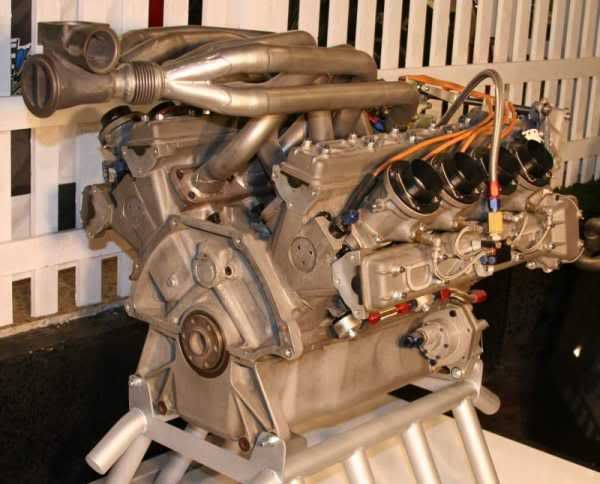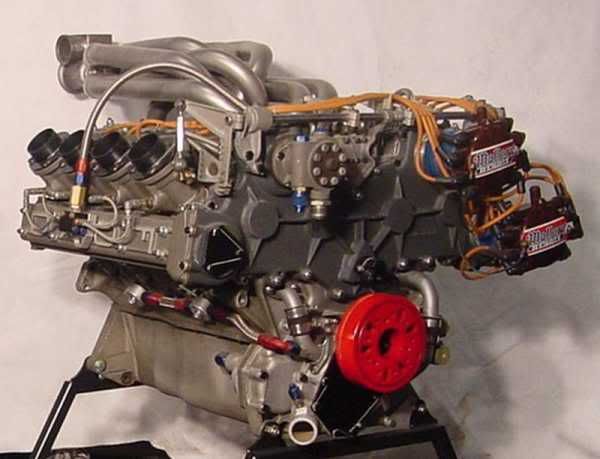Engine Porn
Time for another edition of Engine Porn, an ongoing series featuring classic engines that have not only had a significant impact on the world of motorsports but also have a certain visual and/or aural appeal that cannot be quantified, only felt on a visceral level.
This edition focuses on the long-standing relationship between Ford and the British engineering and manufacturing firm, Cosworth. The engine that has had many iterations in that partnership is the Cosworth V8, namely that designated the "DFV" (Double Four Valve), shown below.

Initially putting out 408 hp, the normally aspirated 3.0 liter (183 cu.in.) DFV was developed for the Lotus 49 in 1967. However, Cosworth decided to offer the engine on a customer basis for any team that wanted to purchase them, and the DFV became the dominant engine from 1968, winning 155 of 262 races through to the turbo era of the early 80's, ultimately making 510 hp at that time.

And, while not really related to the Cosworth offerings, Ford had developed in the 1964 its four cam, fuel injected "Indy" V8 engine, displacing 4.2 liters (255 cu. in.) and developing 475 hp on methanol. This engine, along with the Lotus mid-engine chassis, sealed the fate of the front engined, Offenhauser-powered roadsters in Indy car racing in 1965 when F1 champ, Jim Clark, won the 500. Notice the inverted head design which places the exhaust ports between the cylinder banks and the intake ports between the camshafts. This arrangement makes the engine more compact and able to fit in a tighter space; gives the fuel/air mix a straighter shot to the intake valves; and lends itself well to the 180-degree exhaust configuration which improves exhaust scavenging, boosting overall usable power, especially in mid-range torque production.


This design also lends itself well to turbocharging, and by destroking the motor to achieve the 2.6 liter displacement limit for Indy cars at the time, A.J. Foyt actually purchased the rights to the engine from Ford, renaming it the Foyt engine. Shown below is the 1968 variant.

This engine was soon superceded when the aforementioned Ford-Cosworth DFX variant of the DFV came onto the scene in 1976.
These engines, in addition to giving outstanding performance, also sounded fantastic. With their 10,000+ RPM redlines these little V8's had an incredible howl unique unto themselves. From a mechanical engineering perspective, the Cosworth Ford is without a doubt sexy and worthy of a place in the Engine Porn Hall of Fame.
Take a ride in Patrick Depailler's Cosworth DFV-powered Tyrell F1 during a practice session at the 1978 Long Beach Grand Prix. You'll get the full effect on the second lap when the Ferarri has pulled out of ear-shot. One thing you must take into consideration (beside having cold tires on the out lap) is that the camera he was riding with back then weighed over 20 lbs. - they weren't the magic marker-sized digital units we (barely) see today. And you gotta love the days before pit-lane speed limits!
Here's Dider Pironi at Hockenheim, also in a DFV-powered Tyrell.
And Pironi, again, at Watkins Glen.
This edition focuses on the long-standing relationship between Ford and the British engineering and manufacturing firm, Cosworth. The engine that has had many iterations in that partnership is the Cosworth V8, namely that designated the "DFV" (Double Four Valve), shown below.

Initially putting out 408 hp, the normally aspirated 3.0 liter (183 cu.in.) DFV was developed for the Lotus 49 in 1967. However, Cosworth decided to offer the engine on a customer basis for any team that wanted to purchase them, and the DFV became the dominant engine from 1968, winning 155 of 262 races through to the turbo era of the early 80's, ultimately making 510 hp at that time.
The onset of the turbo era in the early 1980s put an end to the DFV's F1 activities, as even with modifications the 15-year-old engine could not hope to compete with the vast power being put out by the new 1.5 litre turbocharged engines. For a few years, between 1977 when Renault debuted the powerful but unreliable turbo engine, and 1982 when the DFV-powered teams began to negotiate deals for turbo engines of their own, a competitive equilibrium was established. Michele Alboreto took the DFV's last F1 win in a Tyrrell at Detroit in 1983, and Martin Brundle was the last person to race in F1 with a DFV, also in a Tyrrell at the Austrian Grand Prix in 1985.There was also the turbocharged DFX "Indy", a de-stroked, methanol-burining version displacing 2.65 liters for Indy Car racing, shown below. In its final form the DFX developed 840 hp and was the dominant powerplant from 1977 to 1987, having won 10 consecutive Indy 500's and 11 series championships.

And, while not really related to the Cosworth offerings, Ford had developed in the 1964 its four cam, fuel injected "Indy" V8 engine, displacing 4.2 liters (255 cu. in.) and developing 475 hp on methanol. This engine, along with the Lotus mid-engine chassis, sealed the fate of the front engined, Offenhauser-powered roadsters in Indy car racing in 1965 when F1 champ, Jim Clark, won the 500. Notice the inverted head design which places the exhaust ports between the cylinder banks and the intake ports between the camshafts. This arrangement makes the engine more compact and able to fit in a tighter space; gives the fuel/air mix a straighter shot to the intake valves; and lends itself well to the 180-degree exhaust configuration which improves exhaust scavenging, boosting overall usable power, especially in mid-range torque production.



This design also lends itself well to turbocharging, and by destroking the motor to achieve the 2.6 liter displacement limit for Indy cars at the time, A.J. Foyt actually purchased the rights to the engine from Ford, renaming it the Foyt engine. Shown below is the 1968 variant.

This engine was soon superceded when the aforementioned Ford-Cosworth DFX variant of the DFV came onto the scene in 1976.
These engines, in addition to giving outstanding performance, also sounded fantastic. With their 10,000+ RPM redlines these little V8's had an incredible howl unique unto themselves. From a mechanical engineering perspective, the Cosworth Ford is without a doubt sexy and worthy of a place in the Engine Porn Hall of Fame.
Take a ride in Patrick Depailler's Cosworth DFV-powered Tyrell F1 during a practice session at the 1978 Long Beach Grand Prix. You'll get the full effect on the second lap when the Ferarri has pulled out of ear-shot. One thing you must take into consideration (beside having cold tires on the out lap) is that the camera he was riding with back then weighed over 20 lbs. - they weren't the magic marker-sized digital units we (barely) see today. And you gotta love the days before pit-lane speed limits!
Here's Dider Pironi at Hockenheim, also in a DFV-powered Tyrell.
And Pironi, again, at Watkins Glen.
Labels: Engine Porn, Entertainment and Diversion









0 Comments:
Post a Comment
<< Home